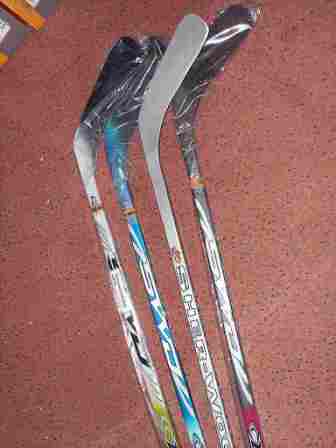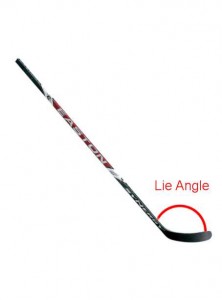Hockey
sticks come in many different shapes, sizes, and curves. All
three of these characteristics can drastically effect ones puck
handling, passing, and shooting skills. First lets start off with
the curve of the blade, if the blade has an intense curve it is going
to be easier to make the puck airborne and a straighter curve will make
it harder to get the puck off the ice. If one makes a lot of
passes, which is generally the defense, they should have a small curve
to help them keep the puck on the ice while passing or taking a hard
shot from the blue line without taking out there team mates. The
offense usually have more of a curve so they can shoot up into the
upper corners of the net with relative ease.
The size of the hockey stick more importantly the length plays a big role also. Like a pendulum the longer it is the faster the end has to go to keep up with top end of the stick which is moving fast at all. Basically the longer the stick the faster ones shot will be, but if its too long it can be hard to control, and one can't go past a certain length because of the rules. Also theres the lie of a stick; the lie of a stick is the angle between the shaft and the blade. The lie needs to be high enought to were the blade of the stick is constantly on the ice in any stance. With out this it would be hard to effectively pass and shoot, also this helps with the bowing of the stick which comes to the matter of flex.
Last of all is the flex of the stick, this is probaly the most important part of the stick. If a player has to much flex their shot will not have much power to it at all because the stick first hits the ice flexes, then springs back and hits the puck with extra velocity. If there isn't enough flex the stick has a great possiblity of snapping in half, and shots and passes will be unaccurate.



http://www.exploratorium.edu/hockey/shooting1.html http://johnochwat.wordpress.com/2008/01/ http://hockeystickexpert.com/hockey-stick-lie-better-puck-control/
The size of the hockey stick more importantly the length plays a big role also. Like a pendulum the longer it is the faster the end has to go to keep up with top end of the stick which is moving fast at all. Basically the longer the stick the faster ones shot will be, but if its too long it can be hard to control, and one can't go past a certain length because of the rules. Also theres the lie of a stick; the lie of a stick is the angle between the shaft and the blade. The lie needs to be high enought to were the blade of the stick is constantly on the ice in any stance. With out this it would be hard to effectively pass and shoot, also this helps with the bowing of the stick which comes to the matter of flex.
Last of all is the flex of the stick, this is probaly the most important part of the stick. If a player has to much flex their shot will not have much power to it at all because the stick first hits the ice flexes, then springs back and hits the puck with extra velocity. If there isn't enough flex the stick has a great possiblity of snapping in half, and shots and passes will be unaccurate.



http://www.exploratorium.edu/hockey/shooting1.html http://johnochwat.wordpress.com/2008/01/ http://hockeystickexpert.com/hockey-stick-lie-better-puck-control/
| Home | Reaction time | The Ice | Hockey Intro | Bibliography |